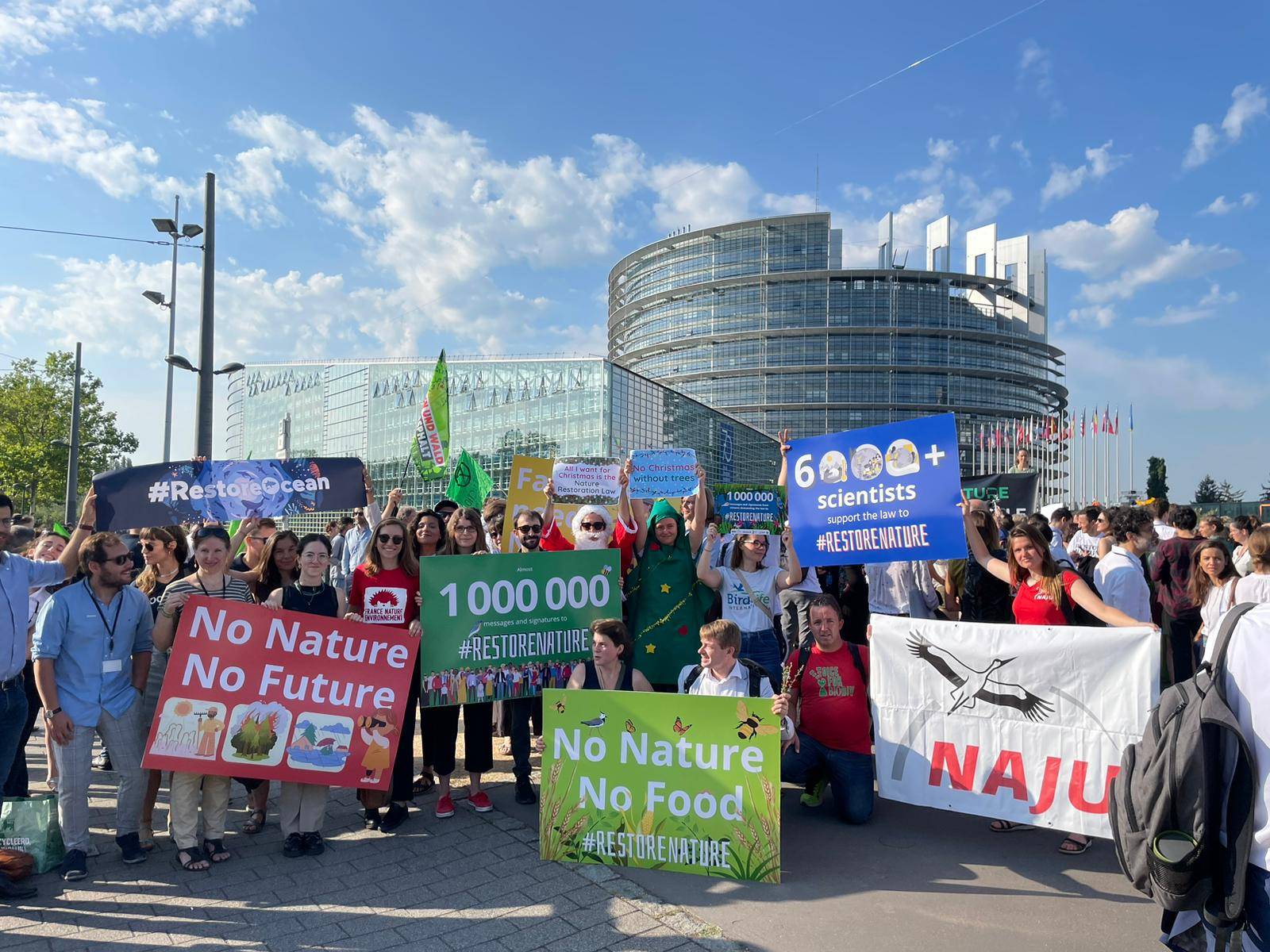Three ERF grantees celebrate as Europe’s Nature Restoration Law edges closer to getting adopted

Campaigners outside European Parliament, Brussels © ClientEarth
19.03.2024
The European Parliament has approved a milestone Nature Restoration Law, aimed at rehabilitating at least 20% of the European Union’s land and sea areas by 2030 and all degraded ecosystems by 2050.
In a significant victory for environmental advocates, the #RestoreNature coalition, (which includes ERF grantee partners BirdLife Europe, ClientEarth, and EEB), has been instrumental in getting the law approved. Their advocacy work has included engaging with key EU policy makers and national decision makers, as well as developing briefing papers, fact sheets, and studies on topics relevant to the Nature Restoration Law for key stakeholders.
This new legislation is important because over 80% of EU habitats are in a poor condition, and the destruction of nature is set to inflict additional costs on farms and ecosystems as pollinators die out, soils degrade and the weather becomes more extreme.
This first continent-wide law of its kind is a “symbol that Europe can, and will, commit to fighting for the survival of our planet”, according to the #RestoreNature coalition. The law will restore degraded ecosystems in all Member States, help achieve the EU’s climate and biodiversity objectives and enhance food security.
The new legislation establishes obligations and time-bound targets for Member States, which will be required to restore a significant portion of habitats covered by the law to good condition: 30% of such terrestrial and marine habitats by 2030, 60% by 2040 and 90% by 2050.
In addition to that, Member States will be obliged to target restoration measures towards farmlands, pollinators, rivers, forests and urban areas in order to gradually reverse the environmental damage caused by climate change and unchecked human activity. These obligations include;
- Reversing the decline of pollinating insect populations by 2030;
- No net loss of green urban space by 2030;
- Increasing grassland butterflies and farmland birds;
- Restoring drained peatlands under agricultural use;
- Restoring marine habitats such as seagrass beds or sediment bottoms; and
- Identifying and removing barriers that prevent the connectivity of surface waters, so that at least 25,000 km of rivers are restored to a free-flowing state by 2030.
Once in good condition, EU countries must take measures to ensure that an area does not significantly deteriorate. Member States will also have to adopt national restoration plans detailing how they intend to achieve these targets.
The approval of the law by the European Parliament comes amidst weeks of fierce protests from farmers. There was also a last-ditch attempt to sink the deal from the European People’s Party (EPP), the biggest group in the European Parliament, as it joined far-right lawmakers in voting against the law.
Opposition to the deal has been successful in watering down the original proposal over the years. Some of these changes include; Of the 30% of agricultural lands lying in drained peatlands that are to be restored, the percentages that will need to be rewetted by certain deadlines have been dropped. The initial proposal was intended to reach 50% of such areas by 2040 and 70% by 2050; however, the final regulation slashed those percentages to 40% and 50%, respectively. There are also farm-related exemptions in the law, including an option to halt certain targets for agricultural ecosystems in case of any “unforeseeable and exceptional events outside of the EU’s control and with severe EU-wide consequences for food security”. There is now also more flexibility to progress reporting and monitoring, which now states that countries need to report on certain progress at least every six years, whereas the first draft of the law had proposed assessments every three years.
Despite these and other changes, the Nature Restoration Law is still a landmark achievement for the restoration of Europe’s habitats. The final step in the process is for the agreement to receive the formal approval of Member States, which is expected to take place on 25 March – something the opponents of the law are still trying to overturn.
Anouk Puymartin of Birdlife said that; “The Parliament’s approval of the Nature Restore Law is a beacon of hope for a continent that is being ravaged by nature and climate crises. This law has the potential to be one of the most impactful pieces of legislation to help farmers, maintain food security, and protect Europeans against fires, floods and droughts. While it’s deeply worrying that a win-win for people, our economy and our planet has created such divides, it’s a relief that Members of Parliament still listen to facts and science.”